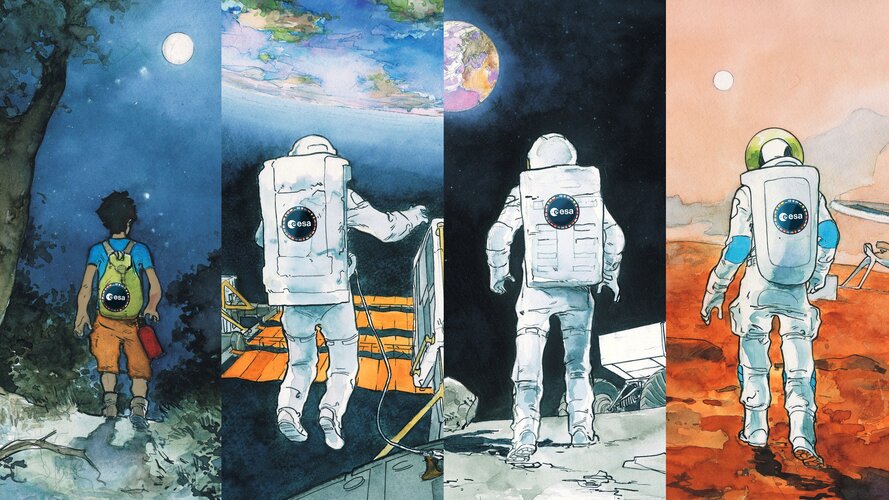
Copernical Team
Tuesday, 05 July 2022 11:12
Teleglobal and Kacific complete large-scale deployment of mobile backhaul services
Singapore (SPX) Jul 05, 2022
 Kacific Broadband Satellites Group (Kacific) has successfully partnered with PT Indo Pratama Teleglobal ("Teleglobal") in Indonesia to provide a large-scale deployment of mobile backhaul services to major telecommunications operators.
Over the last year, the pair have connected hundreds of base sites across the Indonesian territory, capable of 4G services, to Kacific's high-throughput Ka-b
Kacific Broadband Satellites Group (Kacific) has successfully partnered with PT Indo Pratama Teleglobal ("Teleglobal") in Indonesia to provide a large-scale deployment of mobile backhaul services to major telecommunications operators.
Over the last year, the pair have connected hundreds of base sites across the Indonesian territory, capable of 4G services, to Kacific's high-throughput Ka-b
 Kacific Broadband Satellites Group (Kacific) has successfully partnered with PT Indo Pratama Teleglobal ("Teleglobal") in Indonesia to provide a large-scale deployment of mobile backhaul services to major telecommunications operators.
Over the last year, the pair have connected hundreds of base sites across the Indonesian territory, capable of 4G services, to Kacific's high-throughput Ka-b
Kacific Broadband Satellites Group (Kacific) has successfully partnered with PT Indo Pratama Teleglobal ("Teleglobal") in Indonesia to provide a large-scale deployment of mobile backhaul services to major telecommunications operators.
Over the last year, the pair have connected hundreds of base sites across the Indonesian territory, capable of 4G services, to Kacific's high-throughput Ka-b
Published in
News
Tagged under
Tuesday, 05 July 2022 11:12
Turion Space and Exolaunch announce launch agreement for DROID 001 aboard Falcon 9
Irvine CA (SPX) Jul 01, 2022
 US Company Turion Space, building spacecraft for space logistics services including space debris removal and space situational awareness data, has selected Exolaunch, a global provider of launch, deployment and integration services for small satellites, to provide launch services for their first DROID spacecraft aboard a Falcon 9 Transporter rideshare mission.
The launch is planned for ear
US Company Turion Space, building spacecraft for space logistics services including space debris removal and space situational awareness data, has selected Exolaunch, a global provider of launch, deployment and integration services for small satellites, to provide launch services for their first DROID spacecraft aboard a Falcon 9 Transporter rideshare mission.
The launch is planned for ear
 US Company Turion Space, building spacecraft for space logistics services including space debris removal and space situational awareness data, has selected Exolaunch, a global provider of launch, deployment and integration services for small satellites, to provide launch services for their first DROID spacecraft aboard a Falcon 9 Transporter rideshare mission.
The launch is planned for ear
US Company Turion Space, building spacecraft for space logistics services including space debris removal and space situational awareness data, has selected Exolaunch, a global provider of launch, deployment and integration services for small satellites, to provide launch services for their first DROID spacecraft aboard a Falcon 9 Transporter rideshare mission.
The launch is planned for ear
Published in
News
Tagged under
Tuesday, 05 July 2022 11:12
Shedding light on comet Chury's unexpected chemical complexity
Bern, Switzerland (SPX) Jul 05, 2022
 A team of researchers led by the University of Bern has for the first time identified an unexpected richness of complex organic molecules at a comet. This was achieved thanks to the analysis of data collected during ESA's Rosetta mission at comet 67P/ChuryumovGerasimenko, also known as Chury. Delivered to the early Earth by impacting comets, these organics may have helped to kick-start carbon-ba
A team of researchers led by the University of Bern has for the first time identified an unexpected richness of complex organic molecules at a comet. This was achieved thanks to the analysis of data collected during ESA's Rosetta mission at comet 67P/ChuryumovGerasimenko, also known as Chury. Delivered to the early Earth by impacting comets, these organics may have helped to kick-start carbon-ba
 A team of researchers led by the University of Bern has for the first time identified an unexpected richness of complex organic molecules at a comet. This was achieved thanks to the analysis of data collected during ESA's Rosetta mission at comet 67P/ChuryumovGerasimenko, also known as Chury. Delivered to the early Earth by impacting comets, these organics may have helped to kick-start carbon-ba
A team of researchers led by the University of Bern has for the first time identified an unexpected richness of complex organic molecules at a comet. This was achieved thanks to the analysis of data collected during ESA's Rosetta mission at comet 67P/ChuryumovGerasimenko, also known as Chury. Delivered to the early Earth by impacting comets, these organics may have helped to kick-start carbon-ba
Published in
News
Tagged under
Tuesday, 05 July 2022 11:12
Rocket Lab Moon Mission for NASA a Success
Long Beach CA (SPX) Jul 04, 2022
 Rocket Lab USA, Inc. (Nasdaq: RKLB) has successfully deployed a pathfinding satellite for NASA, setting it on a course to the Moon. The deployment marks the successful completion of Rocket Lab's first deep space mission, paving the way for the Company's upcoming interplanetary missions to Mars and Venus.
Owned and operated by Advanced Space on behalf of NASA, the Cislunar Autonomous Positi
Rocket Lab USA, Inc. (Nasdaq: RKLB) has successfully deployed a pathfinding satellite for NASA, setting it on a course to the Moon. The deployment marks the successful completion of Rocket Lab's first deep space mission, paving the way for the Company's upcoming interplanetary missions to Mars and Venus.
Owned and operated by Advanced Space on behalf of NASA, the Cislunar Autonomous Positi
 Rocket Lab USA, Inc. (Nasdaq: RKLB) has successfully deployed a pathfinding satellite for NASA, setting it on a course to the Moon. The deployment marks the successful completion of Rocket Lab's first deep space mission, paving the way for the Company's upcoming interplanetary missions to Mars and Venus.
Owned and operated by Advanced Space on behalf of NASA, the Cislunar Autonomous Positi
Rocket Lab USA, Inc. (Nasdaq: RKLB) has successfully deployed a pathfinding satellite for NASA, setting it on a course to the Moon. The deployment marks the successful completion of Rocket Lab's first deep space mission, paving the way for the Company's upcoming interplanetary missions to Mars and Venus.
Owned and operated by Advanced Space on behalf of NASA, the Cislunar Autonomous Positi
Published in
News
Tagged under
Tuesday, 05 July 2022 11:12
Kongsberg to acquire NanoAvionics; AST SpaceMobile sells stake
Kongsberg, Norway (SPX) Jul 05, 2022
 Kongsberg Defence and Aerospace (Kongsberg) has entered into an agreement to acquire Lithuanian smallsat mission integrator and bus manufacturer NanoAvionics. The planned acquisition expands Kongsberg's space offering to also have products and technology for manufacturing small satellites.
NanoAvionics is a leading smallsat mission integrator and bus manufacturer with significant global gr
Kongsberg Defence and Aerospace (Kongsberg) has entered into an agreement to acquire Lithuanian smallsat mission integrator and bus manufacturer NanoAvionics. The planned acquisition expands Kongsberg's space offering to also have products and technology for manufacturing small satellites.
NanoAvionics is a leading smallsat mission integrator and bus manufacturer with significant global gr
 Kongsberg Defence and Aerospace (Kongsberg) has entered into an agreement to acquire Lithuanian smallsat mission integrator and bus manufacturer NanoAvionics. The planned acquisition expands Kongsberg's space offering to also have products and technology for manufacturing small satellites.
NanoAvionics is a leading smallsat mission integrator and bus manufacturer with significant global gr
Kongsberg Defence and Aerospace (Kongsberg) has entered into an agreement to acquire Lithuanian smallsat mission integrator and bus manufacturer NanoAvionics. The planned acquisition expands Kongsberg's space offering to also have products and technology for manufacturing small satellites.
NanoAvionics is a leading smallsat mission integrator and bus manufacturer with significant global gr
Published in
News
Tagged under
Monday, 04 July 2022 14:25
Earth orbit, Moon, Mars: ESA’s ambitious roadmap

Published in
News
Tagged under
Monday, 04 July 2022 12:18
NASA satellite breaks from orbit around Earth, heads to moon

A satellite the size of a microwave oven successfully broke free from its orbit around Earth on Monday and is headed toward the moon, the latest step in NASA's plan to land astronauts on the lunar surface again.
Published in
News
Tagged under
Monday, 04 July 2022 14:25
From Earth orbit to the Moon and Mars: ESA’s exploration roadmap for space autonomy and leadership

Published in
News
Tagged under
Monday, 04 July 2022 09:30
Watch: Earth Explorer 10 Consultation

Watch: Earth Explorer 10 Consultation
On 5 July, follow the discussion on Harmony at the User Consultation Meeting for ESA's tenth Earth Explorer
Published in
News
Tagged under
Monday, 04 July 2022 09:00
Cosmic manatee accelerates particles from head
 Image:
Cosmic manatee accelerates particles from head
Image:
Cosmic manatee accelerates particles from head
Published in
News
Tagged under

